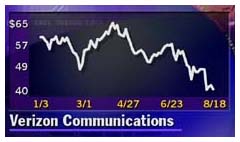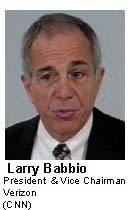|
Verizon talks continue
|
 |
August 21, 2000: 8:18 p.m. ET
CWA faction remains on strike as majority returns to business as usual
|
NEW YORK (CNNfn) - About 35,000 Verizon Communications workers remained on strike Monday evening as negotiators representing employees from the company's mid-Atlantic region continued talks with the telecommunications company's management.
Most of the Verizon strikers returned to work early Monday, just hours after a late-night agreement.
The settlement between the largest U.S. local phone company and two unions, the Communications Workers of America and the International Brotherhood of Electrical Engineers, covers more than 50,000 employees in New England and New York -- the area once served by the former Nynex phone company before it merged with Bell Atlantic in 1997.
 Those still on strike also are represented by the CWA. A company official said Monday the talks on a contract for those employees resumed Monday morning after breaking for some rest just after midnight. Larry Babbio, president of Verizon, said the remaining discussions are about local issues in that region rather than national issues such as overtime, organizing, and wages and benefits. Those still on strike also are represented by the CWA. A company official said Monday the talks on a contract for those employees resumed Monday morning after breaking for some rest just after midnight. Larry Babbio, president of Verizon, said the remaining discussions are about local issues in that region rather than national issues such as overtime, organizing, and wages and benefits.
"Frankly I think at the end of the day those are very simple issues that could have been settled last night," he said at a New York press conference Monday. (488KB WAV) (488KB AIFF)
The CWA said early Monday that disagreements remain in the mid-Atlantic region over major issues including forced overtime levels and the monitoring of customer service employees and operators. A CWA spokeswoman late Monday evening said negotiators are prepared to continue discussions into the night.
Under the agreement reached Sunday, the union workers won an immediate 4 percent pay hike, coupled with a 3 percent hike next year and a 5 percent raise in the third and final year of the contract. Pension benefits increased 14 percent over the life of the contract and union members will receive 100 stock options each by the end of the year for the first time under the deal.
"This will align their interests with ours and hopefully cause us to be motivated in same direction," said Babbio.
In a second interview Monday on CNNfn, Babbio reiterated his belief that the agreement serves the interests of both sides.
"We wanted to make sure we could serve the customers the way we wanted in the future, especially in the new digital services like DSL. It was also important to make sure we got some flexibility in order to stay competitive in some of the new digital services like DSL," Babbio said, adding that the new contract should not affect Verizon's earnings going forward because the company initially told analysts before the merger that it expected a compensation package in the range of Monday's agreement.
Babbio said the economic portions of the tentative pact were among the least difficult issues on which to reach agreement. Michael Balhoff, telecom analyst with Legg Mason, said the economic portion of the deal was good news for investors, who have seen unpleasant earnings surprises and warnings from Verizon in recent weeks.
"The settlement appears to be all within the range of expectations," Balhoff said.
Company says organizing deal not a breakthrough
The company agreed to reduce the amount of involuntary overtime, a key demand of the union, to no more than eight hours a week by next year, although it said it retained the flexibility to use overtime to respond to disasters or other widespread service problems.
And while the company agreed to remain neutral in unionization elections in its wireless units and allow for union recognition through signature of cards rather than a specific vote, it said it only agreed to that for only about 25 percent of its wireless employees nationwide.
 During the strike many said unionization efforts in the primarily nonunion wireless industry made the strike of particular importance for the future of telecommunications. Babbio portrayed company concessions on this point to be relatively minor, though. During the strike many said unionization efforts in the primarily nonunion wireless industry made the strike of particular importance for the future of telecommunications. Babbio portrayed company concessions on this point to be relatively minor, though.
"I want to emphasize this is not automatic unionization," he said. He said that the company was able to limit the deal on unionizing efforts to just the Northeast and mid-Atlantic regions where the union represents local phone workers, and not the company's nationwide wireless operations.
Labor experts are calling the agreement significant in that "old economy" unions have gained a foothold in a sector that is transforming itself into the "new economy."
However, the question of whether unions can strengthen that foothold remains.
"This contract could be a watershed event within the telecommunications industry because a major union has used its existing leverage to break into a new area," said Harley Shaiken, a professor at the University of California at Berkeley who specialized in labor issues. "This isn't simply any company. It's the largest telecommunications employer. On one level it's potentially a watershed event because the union could gain a toehold in the most promising area of telecommunications."
Shaiken also said that the negotiations prove unions may be more important than many at first realized in telecommunications, where fiercely competitive companies are under pressure to push employees to work longer hours and more closely monitor work, rather than hire additional workers at greater cost to handle the load.
Gary Chaison, a professor of industrial relations at Clark University in Bedford, Mass., takes a different view. Chaison agrees the new contract is a significant victory for the unions, but said it was just a battle. Who wins the war is still up for grabs.
Although union members now have more control in terms of more predictable overtime work, keeping jobs in-house and winning the right to organize, those successes could be short-lived if they end up stifling Verizon's ability to remain competitive in terms of keeping costs down and productivity high, Chaison said.
He said the union's demands are somewhat contradictory in that they want all the work done in-house, yet are only willing to endure limited overtime to complete the work.
"I consider this to be the strike of the 21st century, in the sense that it brings together all of the factors unions are going to have to be dealing with in the emerging technology-based growth sectors, dealing with the effect of mergers, countering outsourcing and finding new and faster ways to complete the work," Chaison said.
Those 8,000 wireless employees covered by the agreement are generally employees of what was formerly known as Bell Atlantic Wireless, before the merger with GTE and a joint venture with VodaFone Airtouch formed the current company, Verizon Wireless, which is the largest U.S. wireless provider. Verizon Wireless has a total of 32,000 employees nationwide.
Verizon Communications was formed June 30 through the merger of Bell Atlantic Corp. and GTE Corp., and is one of the largest telecommunications companies in the United States, with about 27 million customers.
Babbio said the agreement was less generous than those agreed upon by some other wireless companies, such as Cellular One, a unit of SBC Communications Inc. (SBC: Research, Estimates).
"I don't see us having set a precedent here. If you look at many wireless companies, they have expansive card check and neutrality rules," he said.
Backlog of service problems, installations
The strike began Aug. 6, and has affected directory assistance, installation and repairs. Storm damage and some vandalism over the past two weeks have added to the repair load, officials said. Babbio said there is a backlog of about 200,000 orders for new lines waiting to be installed, in addition to about 80,000 reports of problems in existing lines. He said in less than half of those lines are out of service, with the majority of service calls being for problems such as noise on the line.
Directory assistance was much closer to returning to normal Monday, with strikers returning to work starting at 12:01 a.m.
"It feels good to be back," one New York directory assistance operator said. The operator, who did not want to give her name, said she was back at work at 7:45 a.m. ET, joining what she said appears to be normal staffing levels.
Some strikers unhappy at partial agreement
But some of the strikers in the mid-Atlantic region are upset that part of the union returned to work and part is still on the picket line, said Rea Patton, president of Local 2203 in Lynchburg, Va.
"That is the sentiment in this local, absolutely," she said. "We're supposed to be one company, one union." Still, Patton said, she believes that a settlement for remaining strikes is imminent.
"The proposed agreement gives Verizon the flexibility we need to thrive in a highly competitive national marketplace," said Babbio.
Shares of Verizon (VZ: Research, Estimates) gained 13/16 to 43-1/4 in trading Monday. 
-- from staff and wire reports
|
|
|
|
|
 |

|

